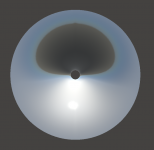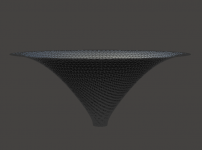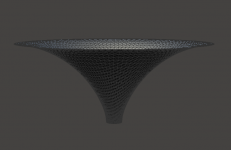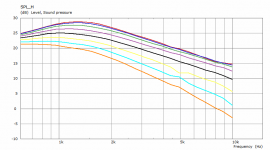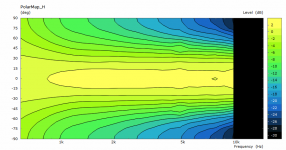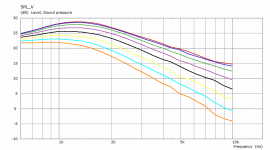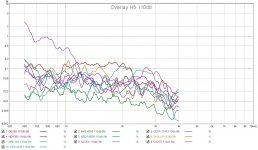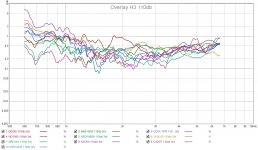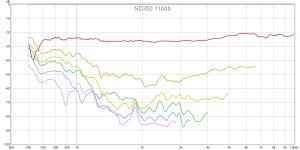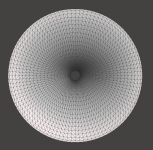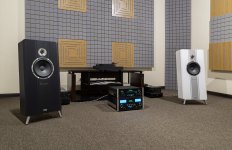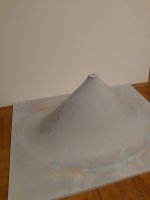So no, I don't agree with your belief in what Floyd would say.
ditto
I think this will be my next waveguide. It is 19" across for a 1.5" throat and I want to go unbaffled this time, with an open baffle woofer. 

Attachments
...as long as "sounds bad" is determined in controlled listening conditions to eliminate non-sonic factors.
If you mean "I had a listen and they sounded bad", or "me and my mates had a listen and we all agreed that they sounded bad", then we have fallen through the rabbit hole and all bets are off.
Very true, though some measurable technical constraints and their contribution to the "experience" cannot be denied.
To finish the discussion on drivers, attached is the distortion plot of the ND350 at 110dB/1m and the overlays of the odd harmonics from all the drivers that were tested at the same level (probably difficult to read).
Translated to 4-6m at the listening spot, this is not an extremely high output level.
The ND350 is one of the best drivers in the test, provided it's not used below 1500Hz.
Comment of the guy who carried out the test:
"If we are interested in a low cut the RCF ND350 is out of the race at high level, on the other hand if we connect to> 1500Hz it is one of the best. The JBL is not comfortable either down there.
On the contrary in the low frequencies the D220Ti dominates the others even if it is much more arbitrary on the rest of the band.
The BMS 4550 also behaves very well at the bottom and is the one with the lowest upper harmonics." (I own this driver as well).
Attachments
Last edited:
I think this will be my next waveguide. It is 19" across for a 1.5" throat and I want to go unbaffled this time, with an open baffle woofer.
Unbaffled as in "free standing"?
Planned crossover ±800Hz?
I might join you, because it is easier to make (using a lathe) than a rectangular WG.
Last edited:
Yep, I just couldn't stand so big enclosure. I don't know yet, but I expect the crossover to be lower than that. That depends on how the woofer radiation pattern will turn out. I'm only beginning to make sketches. For five (or more?) years I haven't touched the microphone...
Last edited:
Hold on, this is NOT axisymmetric. I also want to make it myself but not on a lathe...I might join you, because it is easier to make (using a lathe) than a rectangular WG.
Yep, I just couldn't stand so big enclosure. I don't know yet, but I expect the crossover to be lower than that. That depends on how the woofer radiation pattern will turn out. I'm only beginning to make sketches. For five (or more?) years I haven't touched the microphone...
This WG wil fit on top of my cabs almost perfectly.
I could still "suffer" a few cm extra mouth Ø.
The mic will be dusty by now 😉
This is so simple and brilliant that I almost could not believe it. But not much chance using a lathe 🙂
- It wouldn't be substantially worse if axisymmetric but I like it how it is.
- It wouldn't be substantially worse if axisymmetric but I like it how it is.
Attachments
Last edited:
Hi Marcel,
could you please post an *.stl file for the wave-guide in post 1402?
Kindest regards,
M
could you please post an *.stl file for the wave-guide in post 1402?
Kindest regards,
M
Hold on, this is NOT axisymmetric. I also want to make it myself but not on a lathe...
My mistake!
I just glanced at the fist pic briefly on my phone and missed the differences between H and V.
Attachments
I think this will be my next waveguide. It is 19" across for a 1.5" throat and I want to go unbaffled this time, with an open baffle woofer.
I have a mold of almost that exact waveguide, but it is 1" (smaller drivers work better as you said yourself.) I would let you have it for the shipping cost and the credit. It's not a simple shape to make, cost me >$1000 to have this mold made on a CNC.
Last edited:
doh! that was a mistake i decided to google rectal guide, results where not expected or pretty!
lol
I nearly spit out my coffee and I'm in the middle of a meeting pitching to one of our customers
Really? Now I get curious - was it ever used in your speakers? Wasn't it superior to OSWG, or what is the history of it? Would seem like a fine piece of waveguide.I have a mold of almost that exact waveguide, ...
Of course it would be a great pleasure for me to have it from you. What is your estimate of the shipping cost?I would let you have it for the shipping cost and the credit. It's not a simple shape to make, cost me >$1000 to have this mold made on a CNC.
"Recognize" is a big word in this case. I am quite certain some drivers would stand out, others not so much.
Evidently, the horn used for this test isn't the best match to every driver. Some of these drivers do no lend themselves to a low crossover point, eg. the RCF. Some lack output in the top octave. Finally, diaphragm materials and shapes are definitely a major contributing factor to sound signature imho.
In case you didn't realize it yet, this test was not mine. Why would I buy or otherwise collect eleven 1" drivers, when I already own one of the best (Beyma CP380M), as well as some B&C and BMS 1" drivers?
I permanently switched to 3" diaphragms after comparing 1.75 and 3" drivers at and below 1000Hz. Btw, this is where the CP380M rules, with the exception of a TAD TD2001, or Faital HF20AT behind a deep Salmon horn.
But I prefer a wider sweetspot, so the horn shall be CD.
no I did not realize the test was not yours. Never the less it does not provide the information which seemed to be implied. Matching drivers to horns is critical to obtain the least possible reflections from the horn back into the driver. Folks need to listen and decide for themselves. I have listened to comments from lots of people and when I listened for myself was often shocked by comments made by others and how they conflicted with my own impressions. I have a set of EV DH1A which I like. Have you ever compared them with a CP380M and if so on what horn(s)? I have been using hand made Karlson K-Tubes with double cut away profiles oriented in the vertical plane, from the listening position you can liik almost directly down the tubes.
Really? Now I get curious - was it ever used in your speakers? Wasn't it superior to OSWG, or what is the history of it? Would seem like a fine piece of waveguide.
Of course it would be a great pleasure for me to have it from you. What is your estimate of the shipping cost?
I had it made with the intention of trying it out, but as I proceeded I found that it just didn't make any sense commercially, so there it sits.
As you see it is elliptical with a full OS contour all the way around. I am not sure what the initial angle is however. It would need a back mold made, but these can just be roughed out. It is made of polyurethane boards and can't talk a lot of heat, so fiberglass might not be a great idea. Casting with polyurethane was never a problem, but it hardly generates any heat. It needs to be sealed well or you may have problems with sticking on the first pull.
The board is 20 inches by 15 inches. Throat 1 inch.
I actually have no idea what shipping would cost, but at this point it isn't possible anyways. E-mail me offline when this all clears and we will see what we can do.
Attachments
Last edited:
no I did not realize the test was not yours. Never the less it does not provide the information which seemed to be implied. Matching drivers to horns is critical to obtain the least possible reflections from the horn back into the driver. Folks need to listen and decide for themselves. I have listened to comments from lots of people and when I listened for myself was often shocked by comments made by others and how they conflicted with my own impressions. I have a set of EV DH1A which I like. Have you ever compared them with a CP380M and if so on what horn(s)? I have been using hand made Karlson K-Tubes with double cut away profiles oriented in the vertical plane, from the listening position you can liik almost directly down the tubes.
Wrt to the test I didn't "imply" anything, except for the remark on the RCF ND350's lacking low end, which is a known fact.
I clearly stated: "Judge for yourself whether the differences are significant." 😉
Years ago I was tempted to buy EV DH1As. About 100 NOS pieces were offered locally at €100 each, which is less than the average resale price for (ab)used DH1As today. It's undoubtedly one of the best youngtimer large format drivers, but it's also a heavyweight and requires serious reinforcement of the horn's mounting plate.
Tastes/preferences may indeed (widely) differ from person to person. That's why we have measurements and afterwards all kinds of tools/methods to sugarcoat the acoustically optimized end product.
Last edited:
Toole would probably* also say that compression drivers and larger-than-standard-dome-tweeter-guide waveguides are absolutely unnecessary in home audio, in that they make no difference worth noting. Would that also say a lot?
*just an informed guess
To my knowledge Floyd has never said that, and in my experience with him, he wouldn't. Floyd and I have gone around and around on the issue of directivity, where we don't totally agree. Over the years I believe that he has come further to my approach than I have to his. A waveguide on a dome tweeter has problems with higher DI designs, which are conveniently cured with CDs. Yes the power output of CDs for home use is well over what one actually needs, but it surely doesn't hurt. But if one wants a high DI design with constant directivity then CDs are the way to go.
So no, I don't agree with your belief in what Floyd would say.
Perhaps his actions speak louder than words? link
As per the introduction, "Floyd is a man with means...In creating this system, Floyd did not spare expense, ...the system described below can very well be described as scientifically justified high end -- "
Not a CD to be found. He doesn't have to say it with words: his choices have said it for him. If he deemed them necessary, he would act on that. And he certainly has access to some CD options.....
cheers
- Home
- Loudspeakers
- Multi-Way
- Acoustic Horn Design – The Easy Way (Ath4)
